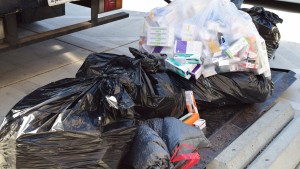Joleen Danker, 57, couldn’t remember exactly how long that box of Claritin had been in her medicine cabinet, but she did remember it was long enough ago that she needed a prescription for it.
“Now you can buy it over the counter, but that was previously, when you couldn’t,” Danker said.
The medicine was old enough that it was surely past its expiration date, so Danker put it in a bag along with some old cold medicine and brought it to the Bacom Community Center, where the San Jose Police Department took it for disposal.
Danker was one of millions of Americans to take part in the 14th National Prescription Drug Take Back Day on Oct. 28. The event, sponsored twice a year by the Drug Enforcement Agency, allows participants to anonymously turn in their unused and expired medication, whether it was prescribed by a doctor or purchased over-the-counter.
According to a press release from the DEA, more than 456 tons of drugs were collected across the country at the October event—a six-ton increase from the 13th Take Back Day last April—making it the most successful event yet. The Take Back Day came two days after President Donald Trump declared the opioid crisis to be a “national health emergency.”
Santa Clara County residents turned in at least one ton of prescription drugs at the county’s 16 collection sites. Sgt. Dave Wilson of the San Jose Police Reserve Unit said that the San Jose Police Department—which collected the bulk of the drugs—took in 85, 33-gallon trash bags at eight locations. Bascom Community Center was one of the busiest locations, having filled at least 10 bags within the first hour.

Blake Alexander, 53, had come to Bascom Community Center to unload more than 100 bottles of medicine, most of which were for his daughter’s health problems. Alexander’s daughter has cystic fibrosis, a genetic disorder that affects the respiratory and digestive systems, for which she takes up to a dozen different drugs per day. Alexander said that he receives “anywhere from 10 to 30 bottles a month” in the mail from pharmacies, some of which go unused.
Alexander also had some leftover ibuprofen from his son’s wisdom teeth removal, as well as hydrocodone—commonly marketed as Vicodin—from his and his wife’s knee surgeries. After holding onto the pills for a few years, Alexander decided it was finally time to throw them out.
“You use those for a couple of days, and then you just tend to stick them in the cabinet and don’t think about them,” Alexander said. “A couple years go by and they’ve expired and you don’t need them anymore, but you don’t want to get rid of them irresponsibly and you don’t want other people to get into them, so you keep them tucked away until you can find a good donation place.”
The DEA’s website includes a search engine to find locations that accept prescription drugs as well as instructions for how to properly dispose of them oneself. The medicine may be mixed with an “undesirable substance, such as used coffee grounds or kitty litter,” per the DEA, then thrown away in a sealed bag. The DEA strongly discourages flushing medicine down the toilet as it may contaminate the environment.
Teenagers looking for drugs “we don’t pay attention to”
Santa Clara County Deputy District Attorney Daisy Nishigaya said that she was driven to increase the county’s participation in the 14th Take Back Day in response to “prevalent” and “pervasive” opioid abuse in Santa Clara County. Nishigaya enlisted more agencies to collect drugs and broadened advertising efforts.
While the opioid crisis has generally hit rural counties in Appalachian and Northeastern states like West Virginia and New Hampshire the hardest, California has not been spared from the epidemic. In 2016, 1,925 Californians died of opioid-related causes, with 66 deaths in Santa Clara County.
Officials do not sort through the medicines before they are handed over to the DEA, so there’s no way to determine what percentage of the pills turned in were opioids.
Nishigaya expressed particular concern about opioid abuse among an unexpected demographic—teenagers.
“I was at a local high school just recently, and they expressed to me the place that teenagers start is when their wisdom teeth come out, or if something else happens to their body where they need medicine,” Nishigaya said. “That’s sort of their first experience with some sort of pain reliever or mind-altering drug, or something of that nature.”
Nishigaya said that high schools that she had visited reported finding painkillers like OxyContin and Vicodin in students’ backpacks. According to Elevate Addiction Services, a California rehabilitation program, prescription opioids such as these can be a gateway to more dangerous, illicit opioids like heroin.
Nishigaya’s fellow deputy district attorney, Erin West, shared her coworker’s concern for teenagers’ susceptibility to opioid addiction. West said that teenagers could easily find prescription drugs in their parents’ medicine cabinets, and compared the danger of having them in the house to that of having a gun.
“They’re looking for drugs that often times we don’t pay attention to,” West said. “We have it in our house, we forget we have it, teenagers find it, and we don’t even realize that it’s gone.”
